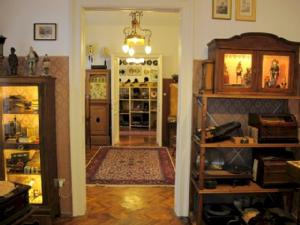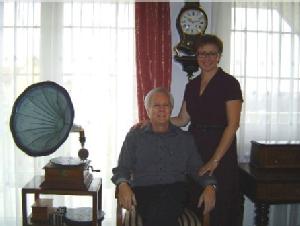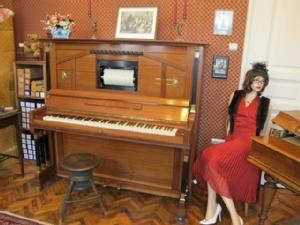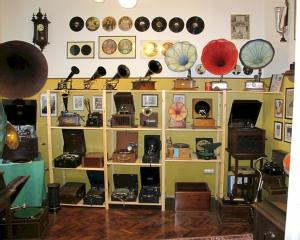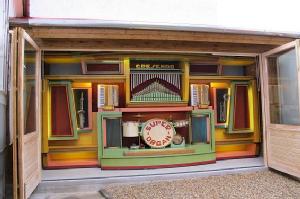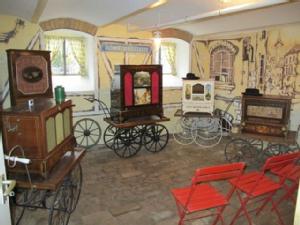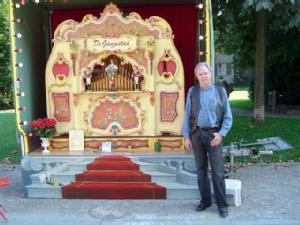
Surber Zeneautomata és Fonográf Múzeuma |
8360 Keszthely, Hungary |
|
| Address |
Surber's museum of automatic musical instruments
Jókai utca 5 |
| Floor area | unfortunately not known yet |
Museum typ
Exhibition
Musical Instruments & Fairground
- Mechanical Music Instruments
- Gramophone (no electrical sound transmission)
|
Opening times
|
Mai - September: Wednesday and Saturday: 12am – 6pm and on request
Május - Szeptember: Szerda és szombat: 12.00-18.00 óráig + igény szerint
|
||||
|
Status from 11/2012
|
Regular 800 ft.; Children 500 ft. Felnöttek 800 ft.; Gyermekek 500 ft. |
||||
| Contact |
|
||||
| Homepage | www.musikautomaten-ungarn.eu | ||||
Our page for Surber Zeneautomata és Fonográf Múzeuma in Keszthely, Hungary, is not yet administrated by a Radiomuseum.org member. Please write to us about your experience with this museum, for corrections of our data or sending photos by using the Contact Form to the Museum Finder.
| Location / Directions |
|
| Description | My interest in antique musical instruments was already waken when I was a child. When I was 10 years old, my mother has to be hospitalized for a while. During these days a very friendly lady (house help) was looking after my younger sister and me. One day, on an school afternoon off, she had an idea to take us to a thrift shop (Brockenhaus). That was a very interesting expierence for me. It was a windup gramophone, which fancied me, so our friendly house help bought it for me for 5 swiss francs. From that day on, the windup gramophone was my everything. My mother wasn't really that happy, but I couldn't stop buying further intstruments. Very soon, there were radios and old grammophones in my room, which I always got for free, because I've been persuasive. Then, when I was 15 and had more pocket money, I bought my first horn gramophone at the Zurich Flea Market. This one as well my first windup gramophone are still a part of my current collection.
Then there was my first mechanical musical instrument, which I got when I was 32 years old and which my mother still had a trouble with. It was a mechanical piano, which came from a heritage of a very far relative of my mother. I couldn't stop bothering her, until she found out, that really nobody of heirs was interested in that piano but me. This is how my collection of mechanical musical instruments started. I couldn't resist an offer of a friend of mine to buy a five meters wide and three meters high Decap dancing organ, while our house in Switzerland was almost exploding due to lack of space. So the question: where should I put this huge organ? Luckily, we had a big barn in our house. So the organ was put on the hayloft. Immediately after that, I started to expand the barn and so we could start our private museum before the winter came. But the space became more a problem: the aisles beetween the instruments became tighter and few years later we reconstructed the attic of our house. During all these years, I extended my know-how and I got to know many friends, collectors, restorers and dealers from all over the Europe. In 2005, I was chosen for the president of Swiss Mechanical Music Society. I occupied this position until our move to Hungary in 2010. What seemed to be impossible in Switzerland (mostly because of the financial and job issues), became possible in Hungary: our dream to start a public museum came true. And I have to say, that it all wouldn't be possible without a big help of my wife. My wife is Russian and she made herself familiar with the mechanical music after our wedding in 2002. She also made some research about the history of mechanical music in Russia and Westeurope, which was and still is unpopular and unknown there. Let's say, she almost rewrote the history of the mechanical music after publishing articles in magazines in this matter. |
| Description (other) |
Интерес к антикварным музыкальным приборам проснулся во мне еще в детстве. Однажды, когда мне было 10 лет, моя мама должна была ненадолго в больницу. На это время за мной и моей младшей сестрой должна была присматривать женщина-помощница. По средам у школьников было свободное от занятий послеобеденное время, и ей пришла идея сходить с нами в магазин подержанных товаров. Мне это было крайне интересно. Там мне очень понравился старый патефон, и добрая женщина купила мне его за 5 франков. С того момента я очень уважал эту добрую женщину. Правда, моя мама была в меньшем восторге, потому что я потерял покой и хотел приобрести другие приборы. И уже вскоре в моей комнате стояли несколько старых радио и патефонов, которые я получил бесплатно, благодаря моему умению убеждать. В 15 лет на мои сэкономленные карманные деньги я купил себе первый граммофон на городском блошином рынке в Цюрихе. Этот граммофон и первый патефон являются и сейчас частью моей коллекции.
Также приобретение первого механического инструмента в возрасте 32 лет несколько напрягло нервы моей матери. Речь шла о механическом пианино, которое было в наследстве от дальних родственников. Я не успокоился, пока мама не выяснила, что никто другой из наследников не имел интереса к этому инструменту. И этим был заложен первый камень моей коллекции механических музыкальных инструментов. Наш дом в Швейцарии уже расползался по швам, и все же я не мог отказаться от предложения одного приятеля и приобрел танцевальный орган Decap, 3 м высотой и 5 м шириной. Но куда же с таким? К счастью к нашему дому был пристроен большой сарай. И уже скоро стоял этот огромный орган на соломенном полу. Немедленно я начал обустраивать пространство вокруг танц. органа, и еще до наступления зимы наш чудесный частный музей был готов. Но пространство существует для того, чтоб его использовать. Со временем проход между инструментами становился все теснее, и несколько лет спустя пришлось обустраивать чердачный этаж нашего дома. В течение лет я расширял мои специальные знания и познакомился со многими коллекционерами, реставраторами, продавцами во всей Европе. |
Radiomuseum.org presents here one of the many museum pages. We try to bring data for your direct information about all that is relevant. In the list (link above right) you find the complete listing of museums related to "Radio & Co." we have information of. Please help us to be complete and up to date by using the contact form above.
[dsp_museum_detail.cfm]
| Data Compliance | More Information |


 musikautomaten-ungarn.eu
musikautomaten-ungarn.eu 